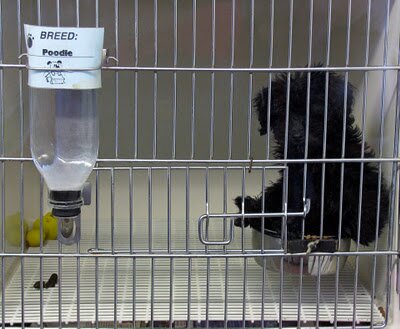This little Poodle pup found the only soft spot in his cage was his food dish. No exercise, no blanket or pad, no life. His parents are probably somewhere in a mill in in the Midwest.
If you ask the staff at a pet store where their puppies come from they will proudly tell you a "USDA licensed" breeder. Sounds impressive, right?
Wrong. USDA standards are minimal, minimally enforced and a far cry from what the average person would consider humane.
The USDA inspector's job is to make sure breeders are adhering to the minimum standards set forth by the Animal Welfare Act (AWA). They can look at a facility with hundreds of dogs in small cages, desperate for human attention, and note no violations. That’s because the Animal Welfare Act (a federal law) does nothing to ensure dogs are happy, or live a quality life.
Here are some quick facts about the minimum standards set forth by the USDA:
- Cage size: must be 6 inches larger than the size of the dog, on all sides
- Up to 12 dogs can be housed in one cage
- Dogs never have to be let out of their cages. Breeders only need to have an exercise plan (seldom enforced)
- There is no limit to the number of dogs a breeder can have—many have over 1,000
- There is no age limit for breeding dogs. If a dog is able to produce puppies for 10 years, that’s how long they could be in the facility
- Inspections are “Risk-based,” meaning that facilities that meet a certain criteria are inspected as seldom as once every 2 to 3 years. There are only about 70 inspectors for over 10,000 facilities.
Wisconsin's Act 90, a new law which provides state regulations and licensing for dog sellers came into effect in June 2011. These are an improvement over the USDA standards; but a Wisconsin pet store can still be using a supplier from a state that doesn't have oversight of it's puppy mills.
When you buy a pet store puppy you are fueling the industry, and encouraging the breeders to produce yet another litter, in their "USDA approved" facility.
Adopt, don't shop this holiday season.


 RSS Feed
RSS Feed